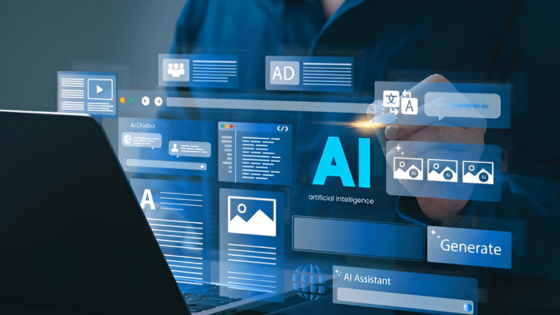Generative AI vs Predictive AI are two distinct branches of artificial intelligence, each offering unique capabilities and serving different purposes. Generative AI is focused on creating new content, such as text, images, and videos, by learning patterns from existing data. It has applications in creative fields like marketing, design, and entertainment. On the other hand, Predictive AI is designed to analyze historical data and predict future outcomes, helping businesses forecast trends, customer behavior, and operational needs. While both technologies rely on machine learning, their applications and goals differ.
Although rooted in AI concepts dating back several decades, generative AI has seen remarkable advancements recently, particularly with the development of Generative Adversarial Networks (GANs) in 2014. GANs enabled machines to create highly realistic content, from images to text, opening the door to various entertainment, healthcare, and marketing applications. In contrast, while also grounded in machine learning, predictive AI focuses on forecasting and optimizing outcomes based on existing data. Both AI technologies have evolved significantly, with applications growing across multiple industries.
Today, generative and predictive AI are transforming how businesses operate. Generative AI has become a powerful tool, with 75% of knowledge workers using it in routine tasks. Marketers, in particular, have recognized its potential, with 59% seeing the benefits of copywriting, although only 26% use it actively. Meanwhile, the predictive AI market is also experiencing rapid growth, expected to reach USD 108.0 billion by 2033, with a 21.9% CAGR over the next decade. Both technologies continue to reshape industries, offering new opportunities and efficiencies.
What is Generative AI, and How It Works?
Generative AI refers to artificial intelligence systems designed to create new content, such as text, images, videos, and music, based on patterns learned from existing data. Unlike traditional AI, which focuses on classification or recognition tasks, generative AI uses machine learning techniques, including Generative Adversarial Networks (GANs) and transformer models like GPT, to produce entirely original outputs. These models analyze vast datasets to identify patterns and structures and then use this knowledge to generate new data that mimic human-like creativity. For example, generative AI can write articles, compose music, or create lifelike images from simple text descriptions, making it a powerful tool for various industries.
The core purpose of generative AI is to automate the creation of high-quality content, streamlining processes that would typically require human involvement. It is designed to augment human creativity, offering new ideas and insights or producing complete content independently.
In marketing, generative AI can generate ad copy, social media posts, and personalized email campaigns, helping businesses maintain consistent content output. In entertainment, it can create scripts, virtual characters, or music, pushing the limits of creative production. By handling repetitive tasks, generative AI frees up human creators to focus on higher-level strategic thinking and innovation.
Generative AI has several key benefits. It significantly increases efficiency by automating content creation, reducing the time required for writing, design, and content personalization tasks. It is also cost-effective, eliminating the need for large teams to produce large volumes of creative content. Furthermore, it enhances creativity by offering new ideas, variations, and innovations that humans might not have conceived alone. With its ability to generate diverse outputs in real-time, generative AI is helping industries like marketing, entertainment, healthcare, and finance unlock new potential, offering novel solutions that improve productivity and drive innovation.
Limitations of Generative AI
- Quality Control: While generative AI can create content quickly, the quality may only sometimes meet human standards, especially in highly creative or nuanced tasks.
- Bias and Inaccuracy: AI models can inherit biases from the data they are trained on, leading to inaccurate or biased outputs.
- Lack of Context: Generative AI may need help understanding the broader context of a task or project, leading to irrelevant or inappropriate content.
- Data Dependency: The effectiveness of generative AI depends heavily on the quality and quantity of data used to train the model. Poor or incomplete data can result in subpar outcomes.
- Ethical Concerns: The ability of generative AI to create realistic content, such as deepfakes or misleading information, raises ethical and legal concerns.
- Creativity Limitation: While generative AI mimics creativity, it lacks true human intuition and emotional depth, which can limit its ability to innovate beyond existing patterns.
- High Computational Requirements: Training large-scale generative AI models demands significant computational resources, which can be expensive and energy-intensive.
Generative AI Applications in Business
- Content Creation: Automating the generation of marketing copy, blog posts, product descriptions, and social media content.
- Customer Support: Generating responses in chatbots and virtual assistants to improve customer service and engagement.
- Personalization: Creating personalized recommendations, offers, and emails based on customer preferences and behaviors.
- Product Design: Assisting in the design of products, packaging, or marketing materials by generating new concepts or variations.
- Creative Media: Producing AI-generated art, music, and video content for advertising, entertainment, and brand campaigns.
- Data Augmentation: Generating synthetic data to supplement real datasets helps train other AI models for testing purposes.
- Healthcare: Designing personalized treatment plans or generating synthetic medical images for research and diagnosis.
- Finance: Assisting in creating financial reports, simulations, and predictive models to aid decision-making.
What is Predictive AI, and How Does It Work?
Predictive AI is a form of artificial intelligence designed to predict future events or outcomes based on historical data and patterns. Predictive AI analyzes large datasets using machine learning algorithms and statistical models to uncover hidden trends and correlations.
These models can forecast future scenarios, from sales and inventory management to customer behavior and financial market movements. Unlike generative AI, which focuses on creating new content, predictive AI’s primary goal is to provide actionable insights by anticipating what will happen next, enabling businesses to make more informed decisions.
The purpose of predictive AI is to help organizations reduce uncertainty and make data-driven decisions. By analyzing historical data and recognizing patterns, predictive AI enables businesses to forecast future trends, such as customer demand, market fluctuations, or potential risks. It is invaluable in finance, where predictive models can forecast stock prices or assess credit risk, and in marketing, they can predict customer behaviors like purchasing decisions or churn.
By leveraging predictive AI, businesses can optimize their strategies, allocate resources more effectively, and stay ahead of potential challenges.
The core focus of predictive AI is on forecasting and risk management. It is centered around using data to anticipate future events or behaviors. Predictive models excel in sales forecasting, where businesses can predict demand and adjust inventory accordingly, and customer behavior analysis, where predictions can help tailor personalized marketing strategies.
The benefits of predictive AI include improved decision-making, increased operational efficiency, and risk mitigation by identifying potential issues before they occur. Predictive AI helps businesses optimize processes and maintain a competitive edge by providing a clearer view of the future.
Limitations of Predictive AI
- Data Dependency: Predictive AI relies heavily on the quality and quantity of historical data. More accurate data can lead to correct predictions and reliable outcomes.
- Model Complexity: Complex predictive models may be difficult to interpret, making it challenging to understand how predictions are made, which can hinder trust in the system.
- Overfitting: Predictive models can sometimes overfit historical data, making them less effective in handling new or unseen situations that deviate from past patterns.
- Bias and Fairness: Like other AI models, predictive AI can inherit biases present in historical data, potentially leading to biased predictions and unfair outcomes.
- Uncertainty: Predictions are never 100% accurate, and external factors (e.g., economic shifts and unexpected events) can undermine their reliability.
- Integration Challenges: Implementing predictive AI across existing systems and workflows can be complex and costly, requiring substantial infrastructure and resources.
- Ethical Concerns: Predictive AI’s use in hiring, credit scoring, and healthcare can raise ethical concerns around privacy, fairness, and transparency.
Generative AI Predictive in Business
- Marketing Personalization: Generative AI can create personalized content, such as product recommendations or targeted ads, based on predictive insights about customer preferences and behaviors.
- Customer Support: By integrating predictive insights with generative AI, businesses can automate customer interactions and provide tailored responses that anticipate customer needs or issues.
- Content Creation: Predictive AI can analyze trends to anticipate the type of content that will perform well. At the same time, generative AI can produce the content (e.g., blog posts and product descriptions).
- Product Development: Predictive AI can forecast market demand or trends, while generative AI can design new products, features, or services based on those predictions.
- Risk Management: Predictive AI can forecast potential risks (financial, operational, or cybersecurity), while generative AI can create contingency plans or simulations to mitigate those risks.
- Supply Chain Optimization: Predictive AI can forecast supply and demand trends, and generative AI can generate optimized schedules, production plans, and logistics strategies based on those insights.
What is the difference between generative AI and predictive AI?
Both generative AI and predictive AI are branches of artificial intelligence, but they serve different purposes and operate using distinct methodologies. Here’s how these two AI technologies differ:
Input or Training Data
Generative AI is typically trained on vast datasets containing diverse and complex samples, such as images, text, or videos. These datasets are often massive, containing millions or even billions of data points because generative models require rich, varied data to learn the underlying patterns and produce realistic, high-quality outputs. In contrast, predictive AI can often work with smaller, more specific datasets tailored to the particular task. Predictive models need targeted data representing past events or behaviors, focusing on the factors that directly influence future outcomes, such as sales data, customer behavior, or financial records.
Output
While generative AI and predictive AI involve a form of prediction, their outputs differ significantly. Generative AI is designed to create new, original content based on patterns learned from training data, whether writing, images, or music. It doesn’t simply replicate existing data but generates novel outputs that resemble the original data’s style, structure, or context. On the other hand, predictive AI forecasts future outcomes by analyzing historical data. It is focused on making predictions about future events, trends, or behaviors, such as predicting customer purchases, stock market trends, or product demand based on patterns identified in the past.
Algorithms and Architectures
Generative AI models utilize various advanced algorithms and architectures, each designed to generate creative content:
- Diffusion models add noise to input data until it becomes unrecognizable, then iteratively “diffuses” the noise to recreate a desired output.
- Generative Adversarial Networks (GANs) consist of two neural networks: the generator, which creates content, and the discriminator, which evaluates the content for authenticity, pushing the generator to improve its outputs over time.
- Transformer models use self-attention mechanisms to analyze the relationships between data points in a sequence, making them ideal for tasks like text generation and machine translation.
- Variational Autoencoders (VAEs) compress training data into more straightforward, low-dimensional forms and generate new samples based on those compressed representations.
In contrast, predictive AI typically employs statistical algorithms and machine learning models, including:
- Clustering algorithms group similar data points to identify patterns.
- Decision trees and random forests make predictions by dividing data into subsets to improve classification accuracy.
- Regression models to identify relationships between variables, such as predicting sales based on customer demographics.
- Time series methods model and forecast data trends over time based on historical patterns.
Explainability and Interpretability
Generative AI models often need more transparency, as the decision-making processes behind the content they generate can be complex and challenging to interpret. The “black-box” nature of these models makes it challenging to explain why certain outputs are produced, which can hinder trust and adoption, particularly in industries requiring clear accountability. On the other hand, predictive AI estimates are generally more interpretable because they rely on statistical models and mathematical principles that can be broken down and explained in more concrete terms. However, even with prediction, there’s still a dependency on human interpretation. Only correct assumptions or misinterpretations of the data can lead to accurate predictions or misguided business decisions.
Generative AI vs. Predictive AI Use Cases
Generative AI and predictive AI serve distinct yet equally valuable roles across industries, offering innovative solutions for various business challenges. Below are some key use cases for both technologies:
Generative AI Use Cases
Generative AI excels in creating new, original content, which has led to its adoption across numerous industries. In customer service, AI-powered chatbots can provide 24/7 personalized support, reducing response times and enhancing customer satisfaction. In gaming, generative AI is used to create dynamic game environments and realistic characters, with studies showing that over 50% of game developers are using AI for content generation. In healthcare, AI-driven synthetic data is helping preserve patient privacy while advancing medical research, with the global generative AI healthcare market projected to grow by 30% annually over the next decade. AI tools generate customized ad copy and visuals in marketing, with 72% of marketers reporting positive ROI from AI-driven content creation. Code generation tools also accelerate software development, reducing time-to-market for new applications.
Predictive AI Use Cases
Predictive AI is widely adopted in finance, retail, and manufacturing, helping businesses make data-driven decisions based on historical patterns. In finance, predictive AI is used to forecast stock prices and market trends, with 80% of financial institutions leveraging AI for risk analysis and forecasting. In retail, predictive models help companies manage inventory levels, projecting demand to optimize stock. In fraud detection, AI algorithms can identify suspicious transactions in real time, with 95% of banks now using AI to combat fraud. Predictive AI analyzes consumer behavior for personalized marketing to create tailored product recommendations, leading to increased sales and customer satisfaction. In supply chain management, predictive models forecast demand and optimize logistics, with 53% of businesses reporting improved efficiency through predictive AI tools.
How Generative AI and Predictive AI Can Power Your Business
Generative AI and predictive AI offer transformative potential for businesses by streamlining operations, enhancing customer engagement, and driving innovation. Generative AI excels in creating personalized content, automating routine tasks, and enhancing creativity. For example, AI-powered chatbots provide 24/7 customer service with personalized responses, reducing costs by 30% while improving customer satisfaction. In marketing, generative AI tools can craft tailored ad copy, visuals, and email campaigns, with 59% of marketers acknowledging its potential for content creation. Generative AI, accelerates coding and debugging in software development in software development, reducing development time by 40%. These capabilities help businesses enhance productivity, scale operations, and deliver exceptional customer experiences.
Predictive AI, on the other hand, helps businesses make data-driven decisions, optimize resources, and anticipate trends. For instance, predictive analytics in supply chain management improves logistics efficiency, with companies reporting up to 15% reduction in operational costs. In finance, predictive AI forecasts market trends and detects fraud, with 80% of financial institutions using it for risk management. Retailers leverage predictive models to optimize inventory, improving stock turnover and reducing excess inventory costs by 20%. By providing actionable insights, predictive AI enables businesses to stay ahead of market changes, reduce risks, and achieve better ROI, making it a critical tool for sustainable growth.
FAQs – Generative AI and Predictive AI
Is ChatGPT generative AI or predictive AI?
ChatGPT is generative AI. It generates text-based responses by analyzing input data and creating new, contextually relevant content based on patterns learned from large datasets.
What is an example of generative AI?
An example of generative AI is DALL·E, which can generate original images from text descriptions, or GPT models like ChatGPT, which generate human-like text for various purposes such as writing, coding, or customer support.
Is chatbot a generative AI or predictive AI?
Depending on its design, a chatbot can be either generative AI or predictive AI. Generative AI chatbots create dynamic responses based on input, while predictive AI chatbots use past interactions and data to predict and provide likely responses.
Conclusion: Generative AI vs Predictive AI
In conclusion, Generative AI and Predictive AI represent two distinct yet complementary technologies that can revolutionize business operations. Generative AI creates new, innovative content, enhances creativity, and automates tasks, making it invaluable in marketing, gaming, and healthcare.
On the other hand, Predictive AI focuses on forecasting future outcomes, helping businesses optimize resources, reduce risks, and make data-driven decisions in sectors like finance, retail, and supply chain management.
While each has its unique strengths, when used together, these technologies can provide comprehensive solutions that drive efficiency, growth, and competitive advantage across industries. As both fields continue to evolve, their combined impact on businesses is set to grow, offering endless possibilities for innovation and transformation.






